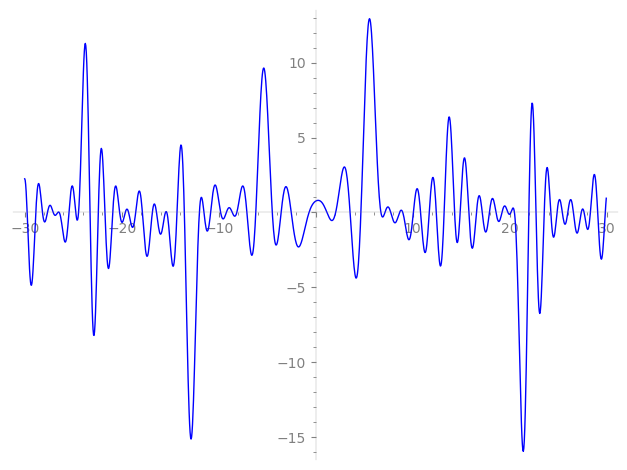| L(s) = 1 | − 2.25·2-s + (1.40 + 1.40i)3-s + 3.06·4-s + (−2.22 + 0.247i)5-s + (−3.16 − 3.16i)6-s + 1.27i·7-s − 2.39·8-s + 0.947i·9-s + (5.00 − 0.558i)10-s + (3.86 − 3.86i)11-s + (4.30 + 4.30i)12-s − 2.87i·14-s + (−3.47 − 2.77i)15-s − 0.731·16-s + (−2.27 − 2.27i)17-s − 2.13i·18-s + ⋯ |
| L(s) = 1 | − 1.59·2-s + (0.811 + 0.811i)3-s + 1.53·4-s + (−0.993 + 0.110i)5-s + (−1.29 − 1.29i)6-s + 0.482i·7-s − 0.848·8-s + 0.315i·9-s + (1.58 − 0.176i)10-s + (1.16 − 1.16i)11-s + (1.24 + 1.24i)12-s − 0.768i·14-s + (−0.896 − 0.716i)15-s − 0.182·16-s + (−0.552 − 0.552i)17-s − 0.502i·18-s + ⋯ |
\[\begin{aligned}\Lambda(s)=\mathstrut & 845 ^{s/2} \, \Gamma_{\C}(s) \, L(s)\cr =\mathstrut & (0.988 + 0.147i)\, \overline{\Lambda}(2-s) \end{aligned}\]
\[\begin{aligned}\Lambda(s)=\mathstrut & 845 ^{s/2} \, \Gamma_{\C}(s+1/2) \, L(s)\cr =\mathstrut & (0.988 + 0.147i)\, \overline{\Lambda}(1-s) \end{aligned}\]
Particular Values
| \(L(1)\) |
\(\approx\) |
\(0.757346 - 0.0563214i\) |
| \(L(\frac12)\) |
\(\approx\) |
\(0.757346 - 0.0563214i\) |
| \(L(\frac{3}{2})\) |
|
not available |
| \(L(1)\) |
|
not available |
\(L(s) = \displaystyle \prod_{p} F_p(p^{-s})^{-1} \)
| $p$ | $F_p(T)$ |
|---|
| bad | 5 | \( 1 + (2.22 - 0.247i)T \) |
| 13 | \( 1 \) |
| good | 2 | \( 1 + 2.25T + 2T^{2} \) |
| 3 | \( 1 + (-1.40 - 1.40i)T + 3iT^{2} \) |
| 7 | \( 1 - 1.27iT - 7T^{2} \) |
| 11 | \( 1 + (-3.86 + 3.86i)T - 11iT^{2} \) |
| 17 | \( 1 + (2.27 + 2.27i)T + 17iT^{2} \) |
| 19 | \( 1 + (-0.861 + 0.861i)T - 19iT^{2} \) |
| 23 | \( 1 + (0.117 - 0.117i)T - 23iT^{2} \) |
| 29 | \( 1 + 9.71iT - 29T^{2} \) |
| 31 | \( 1 + (-0.233 - 0.233i)T + 31iT^{2} \) |
| 37 | \( 1 + 1.32iT - 37T^{2} \) |
| 41 | \( 1 + (-0.354 - 0.354i)T + 41iT^{2} \) |
| 43 | \( 1 + (4.71 - 4.71i)T - 43iT^{2} \) |
| 47 | \( 1 + 3.20iT - 47T^{2} \) |
| 53 | \( 1 + (-4.49 - 4.49i)T + 53iT^{2} \) |
| 59 | \( 1 + (-0.00162 - 0.00162i)T + 59iT^{2} \) |
| 61 | \( 1 - 1.39T + 61T^{2} \) |
| 67 | \( 1 - 6.07T + 67T^{2} \) |
| 71 | \( 1 + (8.59 + 8.59i)T + 71iT^{2} \) |
| 73 | \( 1 - 7.34T + 73T^{2} \) |
| 79 | \( 1 - 11.1iT - 79T^{2} \) |
| 83 | \( 1 - 2.65iT - 83T^{2} \) |
| 89 | \( 1 + (-5.09 - 5.09i)T + 89iT^{2} \) |
| 97 | \( 1 - 4.18T + 97T^{2} \) |
| show more | |
| show less | |
\(L(s) = \displaystyle\prod_p \ \prod_{j=1}^{2} (1 - \alpha_{j,p}\, p^{-s})^{-1}\)
Imaginary part of the first few zeros on the critical line
−9.803351024004862982733989613895, −9.214041845073280274956445310209, −8.602655831236792227472382856637, −8.135318774897918682219781066257, −7.09428962115730661876863864252, −6.17810495567229884912924989339, −4.47608690555819148421570709042, −3.56660808501714560893422323470, −2.52367060365811621525900397360, −0.68957768887780218804810015583,
1.15610720811125059206782150672, 2.05386121911034814085845787400, 3.54257477019870971096549918944, 4.65797815775650689131631823726, 6.72174891461771276331820696607, 7.13592589889713546594227636425, 7.73359359021747272196559354354, 8.641256540520307552761705146783, 8.971022385804622529821830649745, 10.06695373605538609321993144664

